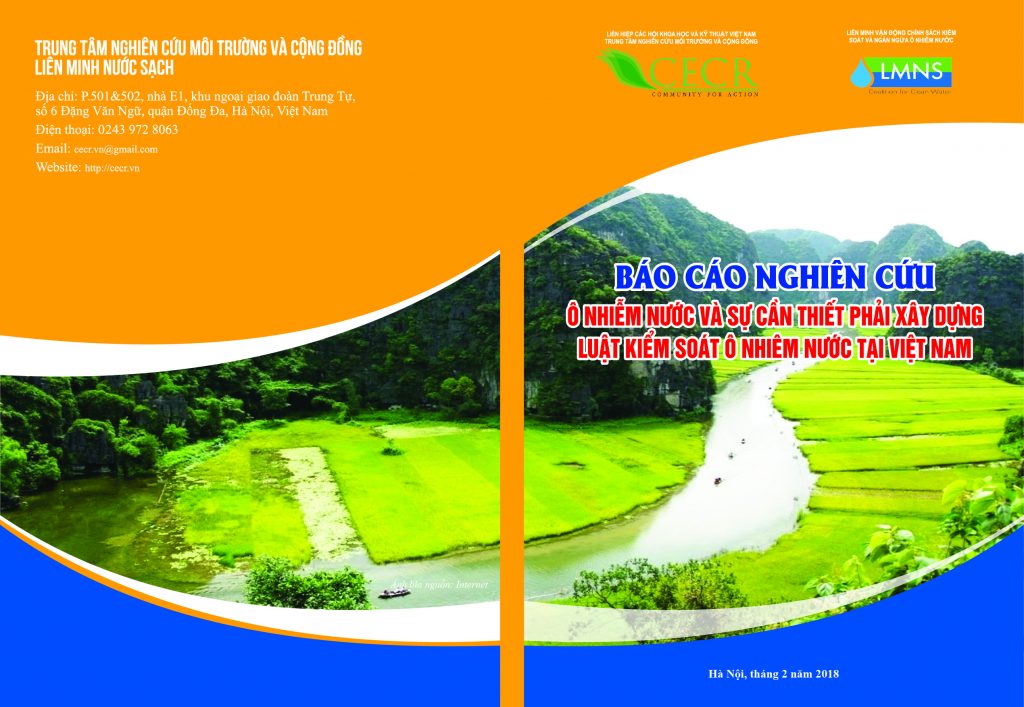WATER CONSERVATION
Vietnam has a relatively rich surface water source with about 3450 rivers and streams over 10 km long and thousands of lakes, ponds and wetlands. However, many of them are facing unsustainable challenges as Vietnam’s water source depends very much on foreign countries; water resources are distributed unevenly in space and time; natural disasters and climate change, and especially the deterioration of water quality due to pollution sources. Although the government has stipulated provisions on surface water conservation including the control of waste sources, environmental protection of river and other water sources in the Law on Environmental Protection 2020 and the Law on Water Resources 2012, surface water quality in Vietnam has been facing serious deterioration in all 63 provinces. In urban areas and industrial areas, water in rivers, streams, and canals is polluted and becomes hazardous to humans and aquatic life. Typically, in Hanoi, the To Lich, Set and Kim Nguu rivers have become part of the wastewater drainage system, which have been blemished by their black-colored look and sewer smell. To control water pollution requires a lot of efforts, commitment, participation and joint efforts of all governments, communities, businesses and scientific organizations, scientists, to reduce damage to the aquatic environment.
To contribute to the protection, improvement and restoration of Vietnam’s surface water sources, CECR focuses on activities:
- Promoting and coordinating multi-sectoral partner networks to join hands in effective water conservation actions.
- Promoting models of joining hands to conserve water in homes, schools, businesses and communities and programs to raise public awareness in water conservation.
- Improving policies related to water conservation through:
+ Carrying out specialized studies on water conservation as a scientific basis for policy advocacy activities, including studying and applying scientific methods on community participation in developing strategic plans for surface water protection; research, review and analysis of current legal documents related to water security, water reuse, control of discharge sources causing surface water pollution; the study of lessons from abroad; case studies of typical water pollution…
+ Based on scientific evidences from researches, policy advocacy is carried out by CECR through policy dialogues with state management agencies, legislators through communication channels such as organizing meetings and conferences, seminars, professional conferences, building reports, professional articles published on the mass media, etc.
Typical CECR projects/programs in the areas of:
Collective Actions for Water Conservation (2020 – 2023): The project is implemented with the support of USAID, with the aim of connecting organizations, communities, and businesses to raise society’s awareness about water conservation, and develop plans to improve water quality. Through this project, the Vietnam Water Conservation Network (VIWACON) was established and supported with capacity building programs tocollectively implement and promote activities/initiatives. The project focuses on water protection, pollution control, and community-based smart water use in Da Nang and supports the completion and implementation of Vietnam’s policy on water conservation and effective water pollution control through technical assistance to the Ministry of Natural Resources and Environment and other legislative bodies such as the National Assembly’s Environmental Science and Technology Committee.
Coalition Program for Policy Advocacy for Water Pollution Prevention and Control – Clean Water Alliance (2014 – 2021): Established and initiated by CECR in 2014 with the support of Oxfam (DFIT/DFAT). The Clean Water Alliance was established with the goal of bringing together NGOs, regulators, scientific agencies, media organizations, communities, businesses, scientists, jurists and environmentalists to work together and supervise the development and implementation of policies on water pollution control in Vietnam. This, therefore, would contribute to the protection of water resources against industrial pollution and other pollution sources, ensuring ensure safe access to water for economic activities and people’s livelihood. Up to now, the Alliance has 30 key members in Son La, Da Nang, Hanoi, Bac Ninh, Quang Nam, Binh Duong, Thai Binh, and Can Tho. A community network has been formed to participate in the protection and monitoring of water resources which have been seriously polluted to the extend that it would also affect the health of the people living around it. Through this program, concepts, principles, policy analysis, practical lessons and international experiences in water pollution control have been systematized, developed and widely proposed on various mass media. Simultaneously, they have been shared with relevant state management agencies through the publication “Research report: Water pollution and the need to develop a Law on Water Pollution Control in Vietnam”.


 Tiếng Việt
Tiếng Việt